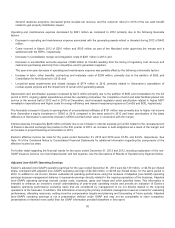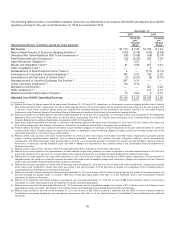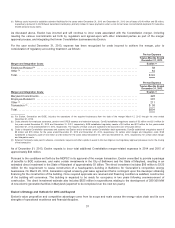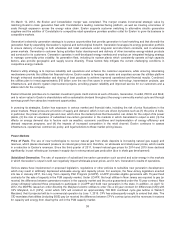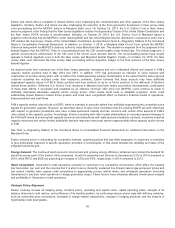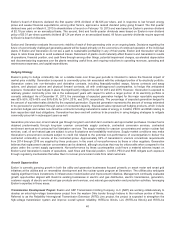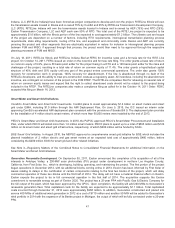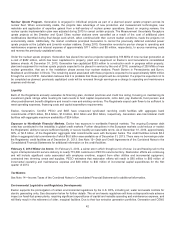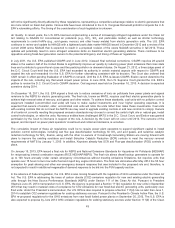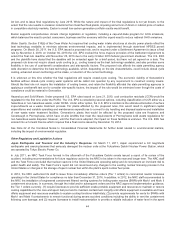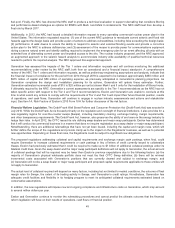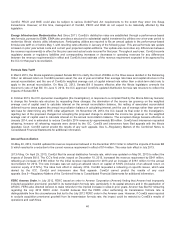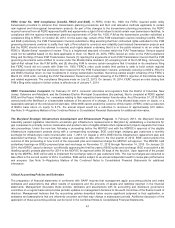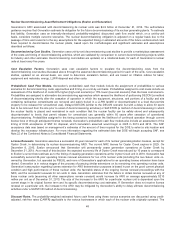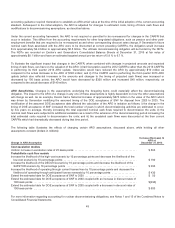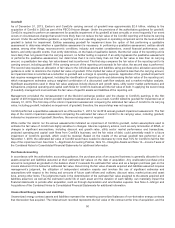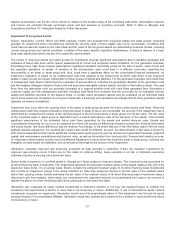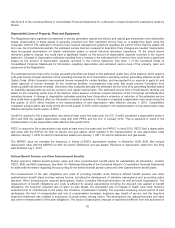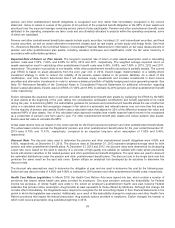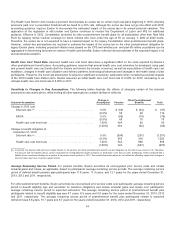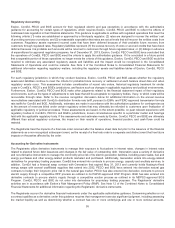ComEd 2013 Annual Report Download - page 51
Download and view the complete annual report
Please find page 51 of the 2013 ComEd annual report below. You can navigate through the pages in the report by either clicking on the pages listed below, or by using the keyword search tool below to find specific information within the annual report.fuel pool.Finally, theNRChasdirectedtheNRCstaff to produceatechnical evaluation to support rulemakingthat considersfiltering
andperformance-basedstrategiesasoptionsfor BWR’s withMarkIandMarkIIcontainments. TheNRCstaff mustthen develop a
final rule by March 2017.
Additionally, in 2012,theNRChad issuedadetailedinformation requesttoeveryoperatingcommercial nuclear power plant inthe
UnitedStates. Theinformation requestedrequires: (1)useofthecurrent NRCguidance to reevaluate current seismic andfloodrisk
hazards againstthedesignbasis andprovide a plan ofactionsto address vulnerabilities, includingrisks exceedingthedesignbasis;
(2)performanceofwalkdownsto ensure theabilityto respondto seismic andexternal floodingeventsandprovideacorrective
action plan to theNRCto address deficiencies; and(3)assessment ofthemeansto providepower for communicationsequipment
duringasevere natural event andidentify staffingrequiredto implement theemergency plan for an event affectingall unitswithan
extendedloss ofalternatingcurrent power andimpededaccess to thesite.Thenuclear industryproposed, andtheNRCapproved,
an augmentedapproach to theseismic hazardanalysis to accommodate industry wideavailabilityofqualifiedtechnical resources
neededto performtherequiredanalysis. TheNRCapprovedthis augmentedapproach.
Generation hasassessedtheimpactsoftheTier 1 ordersandinformation requestsandwill continue monitoringtheadditional
recommendationsunder reviewbytheNRCstaff, bothfroman operational andafinancial impactstandpoint.Acomprehensive
reviewoftheNRCTier 1 ordersandinformation requests, aswell aspreliminaryengineeringassumptionsandanalysis, indicate that
thefinancial impactofcompliancefor the periodfrom2014through 2018isexpectedto bebetween approximately$350million and
$375 million ofcapital and$50million ofoperatingexpense,aspreviouslyanticipatedinGeneration’s planningprojections. As
Generation completesthedesignandinstallation planningfor itsactions, Generation will update theseestimates. Further,
Generation estimatesincremental costsof$15to $20 million per unit at eleven MarkIandIIunitsfor theinstallation offilteredvents,
if ultimatelyrequiredbytheNRC. Generation’s current assessmentsare specific to theTier 1 recommendationsastheNRChasnot
taken specific action withrespecttotheTier 2 andTier 3 recommendations. Exelon andGeneration are unable to concludeatthis
timetowhat extent anyactionsto complywiththerequirementsofTier 2 andTier 3 will impacttheirfuture financial position,results
ofoperations, andcash flows. Generation will continue to engageinnuclear industryassessmentsandactionsandstakeholder
input.See Item1A.Risk FactorsofExelon’s 2013 Form10-K for further discussion oftherisk factors.
Financial Reform Legislation. TheDodd-FrankWall Street ReformandConsumer Protection Act(Dodd-FrankAct)wasenactedin
July2010. While theDodd-FrankActis focusedprimarilyon theregulation andoversightoffinancial institutions, italso providesfor a
newregulatoryregimefor over-the-counter swaps (Swaps), includingmandatoryclearing, exchange trading, marginrequirements,
andother transparency requirements. TheDodd-FrankAct,however,also preservestheabilityofendusersinthe energy industryto
hedgetheirrisks. In April 2012,theCFTC issueditsrule definingswap dealersandmajor swap participants. Exelon hasdetermined
that itwill conductitscommercial business inamanner that doesnot require registration asaswap dealer or major swap participant.
Notwithstanding, there are additional rulemakings that have not yet been issued, includingthecapital andmargin rules, which will
further define thescope oftheregulationsandprovideclarityasto theimpactontheRegistrants’ business, aswell asto potential
newopportunities. Dependingon thesefinal rules, theRegistrantscouldbesubjecttosignificant newobligations.
The proposedregulationsaddressingcollateral andcapital requirementsandexchangemargincash postings, when final,could
require Generation to increasecollateral requirementsor cash postings inlieu oflettersofcreditcurrently issuedto collateralize
Swaps. Exelon hadpreviouslyestimatedthat itcouldberequiredto makeupto$1billion ofadditional collateral postings under its
bilateral creditlines. Given theswap dealer andthemajor swap participant definitionswill not applyto Generation,theactual amount
ofcollateral postings that will berequiredmaybelower than Exelon’s previousexpectationsdue to thefollowingfactors: (a)the
majorityofGeneration’s physical wholesale portfoliodoesnot meet thefinal CFTC Swap definition; (b) there will beminimal
incremental costsassociatedwithGeneration’s positionsthat are currentlyclearedandsubjecttoexchangemargin;and
(c) Generation will not beaswap dealer or major swap participant andproposedcapital requirementsapplicable to these entitieswill
not applyto Generation.
Theactual level ofcollateral requiredwill dependon manyfactors, includingbut not limitedto market conditions, the outcomeoffinal
margin rulesf
or Swaps, theextent ofitstradingactivityinSwaps, andGeneration’s credit ratings. Nonetheless, Generation has
adequate creditfacilitiesandflexibilityinitshedgingprogramto meet itsanticipatedcollateral requirementsestimatedbasedon
conservativeassumptions.
Inaddition,thenewregulationswill imposenewandongoingcomplianceandinfrastructure costson Generation, which mayamount
to several million dollarsper year.
Exelon andGeneration continue to monitor the rulemakingproceduresandcannot predictthe ultimate outcomethat thefinancial
reformlegislation will haveontheirresultsofoperations, cash flows or financial position.
45


